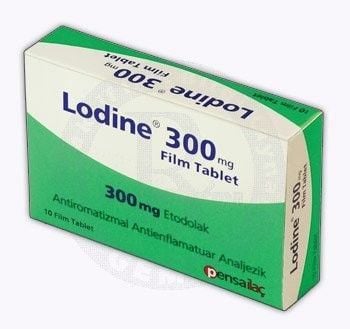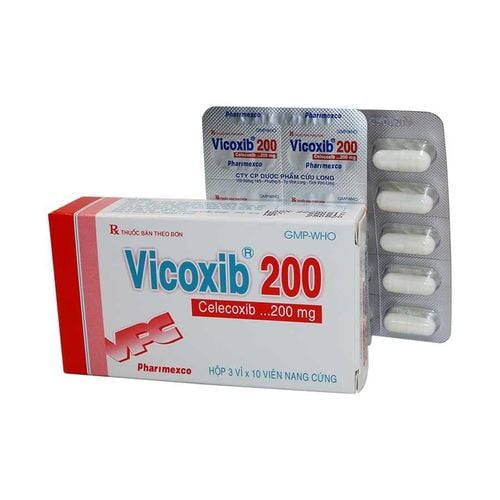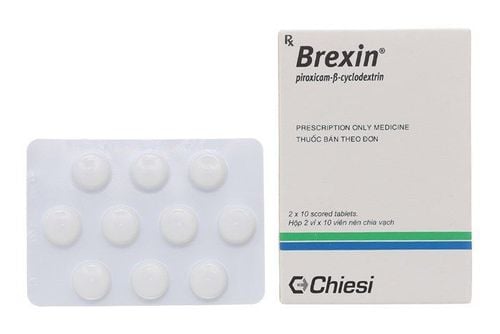This is an automatically translated article.
Conoges 200mg drug belongs to the list of non-steroidal anti-inflammatory drugs. The following is information about the uses, dosage and precautions when using Conoges 200mg medicine.
1. What does Conoges 200mg do?
Conoges medicine 200mg has the main ingredient is Celecoxib, is made in the form of capsules and the packaging is a box of 3 blisters x 10 tablets.
The effect of the drug Conoges 200mg is to treat symptoms of osteoarthritis, rheumatoid arthritis in adults, to treat acute pain (after surgery, tooth extraction), to treat primary dysmenorrhea, to support treatment in The reduction of polyps in the conventional therapy of familial adenomatous polyposis.
2. Dosage & How to take Conoges 200mg
Dosage:
Treatment of osteoarthritis: Usually used with a dose of 200mg/day, used once or divided into two doses twice a day; Treatment of rheumatoid arthritis: Use dose of 100-200mg x 2 times/day; Treatment of ankylosing spondylitis: 200mg/day or 100mg x 2 times/day; Treatment of colorectal polyps: 400mg/time x 2 times/day; For general pain and dysmenorrhea: The usual dose in adults is 400mg/time/day, continue treatment with 200mg if needed and on the first day. To continue to relieve pain can use a dose of 200mg x 2 times / day. Usage:
Osteoarthritis treatment: Drink once a day or divided into two to use twice, both have the same effect; Treatment of rheumatoid arthritis: Take the dose divided into 2 times / day; If the dose is up to 200mg / time, 2 times a day, it can be taken with food or not; If the dose is up to 400mg / time, take 2 times a day, take with meals (with food).
3. Note when using the drug Conoges 200mg
Contraindications:
People with hypersensitivity to any component of the drug; People with a history of allergy to sulfonamides; Women who are pregnant or breastfeeding; People with severe heart, kidney and liver failure; inflammatory bowel disease, including Crohn's disease, ulcerative colitis. Side effects:
Common:
Digestive disorders: Abdominal pain, diarrhea, indigestion, flatulence, nausea; Having problems in the respiratory tract: Pharyngitis, rhinitis, sinusitis, upper respiratory tract infection; Effects on the central nervous system: Insomnia, dizziness, headache; Dermatological effects: Appearance of a rash on the skin; General condition: Back pain, peripheral edema. Rare:
Effects on the cardiovascular system: Syncope, congestive heart failure, ventricular fibrillation, pulmonary embolism, cerebrovascular accident, peripheral gangrene, thrombophlebitis, vasculitis; Effects on the gastrointestinal tract: Intestinal obstruction, intestinal perforation, gastrointestinal bleeding, hemorrhagic colitis, esophageal perforation, pancreatitis; Affects the liver - bile: Having gallstones, hepatitis, jaundice, liver failure; Hematological disorders: thrombocytopenia, agranulocytosis, non-regenerative anemia, pancytopenia, leukopenia; Metabolic disorders: Decreased blood glucose; Effects on the central nervous system: Ataxia, suicidal delusions; Affects the kidneys: Acute renal failure, interstitial nephritis Dermatological effects: Erythema multiforme, exfoliative dermatitis, Stevens - Johnson syndrome; General condition: Infection, sudden death, anaphylactoid reaction, angioedema. Caution when using Celecoxib:
Although the drug does not cause gastrointestinal complications by selective COX-2 inhibition, it should be used with caution in patients with a history of gastric ulcer, duodenal ulcer, or gastrointestinal bleeding. ; Because it is easy to cause gastrointestinal bleeding and the risk of kidney function decline in age, it should be used with caution in the elderly and debilitated people; Celecoxib has a risk of nephrotoxicity, especially when maintaining renal blood flow requires renal prostaglandins, so patients with heart failure, liver failure, and renal failure should use caution; The drug has the ability to cause fluid retention, making the disease worse, so it should be used with caution in people with edema, fluid retention in patients with heart and kidney failure; In persons with extracellular water loss due to strong diuretics, dehydration should be treated prior to administration of Celecoxib; Patients with familial adenomatous polyposis need endoscopic follow-up, prophylactic colectomy when needed. The risk of cardiovascular complications should be monitored. For example myocardial infarction, myocardial ischemia. In case of prolonged high dose (400-800 mg/day), it is necessary to prevent myocardial ischemic events, because Celecoxib has no intrinsic antiplatelet activity. For pregnant women: Use only when needed and have carefully weighed the benefits and risks. Do not use the drug in the third trimester of pregnancy, because prostaglandin synthesis inhibitors can have adverse effects on the cardiovascular system of the fetus; For women who are breastfeeding: Use only when absolutely necessary and carefully weigh the benefits and risks; Effects on ability to drive and use machines: Dizziness is possible, so caution should be exercised when driving and operating machinery. Hopefully with the information about the drug Celecoxib will help the process of treatment and use of the drug in patients effectively and safely. If you have any further questions, you can discuss further with a specialist.
Please dial HOTLINE for more information or register for an appointment HERE. Download MyVinmec app to make appointments faster and to manage your bookings easily.













